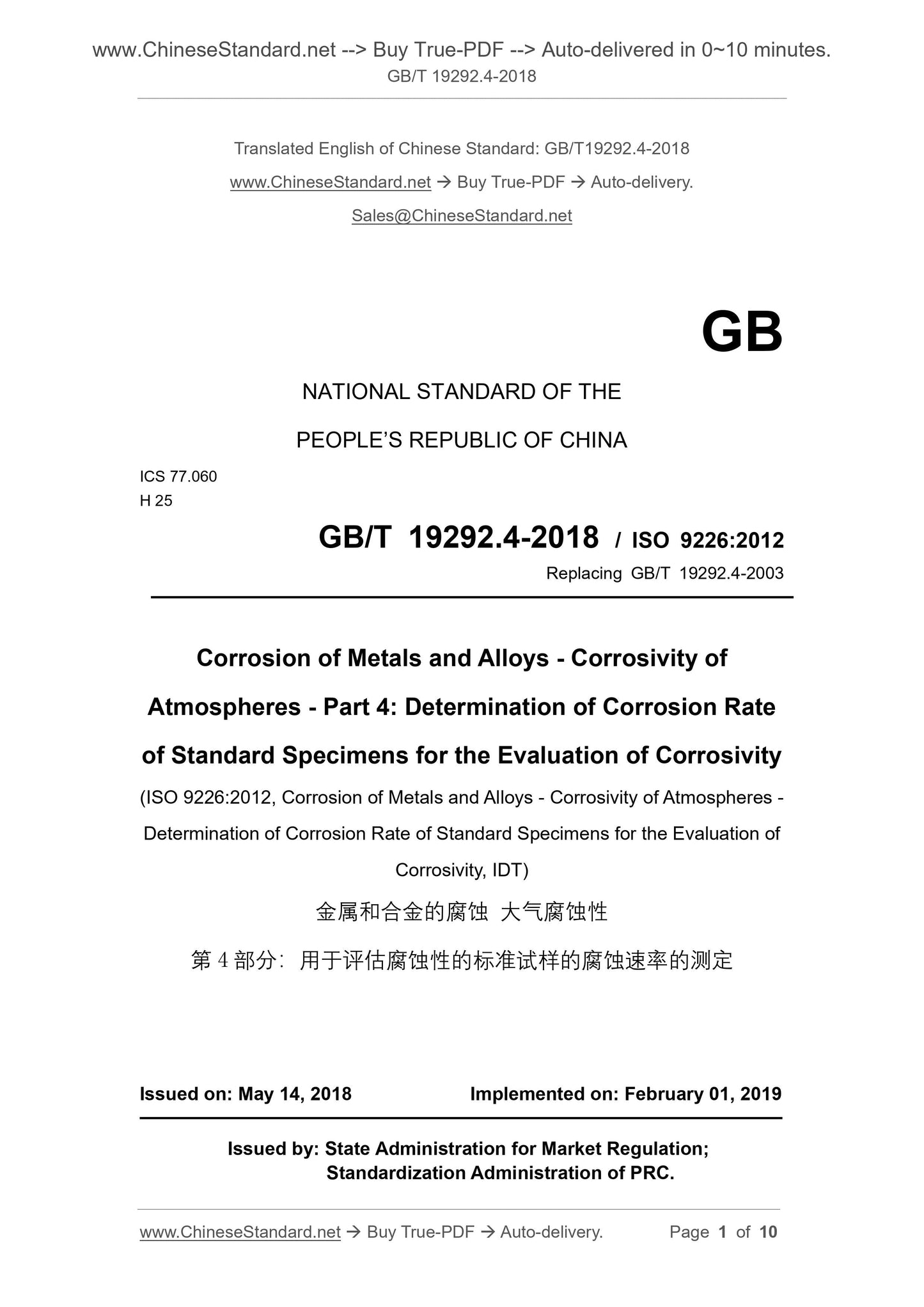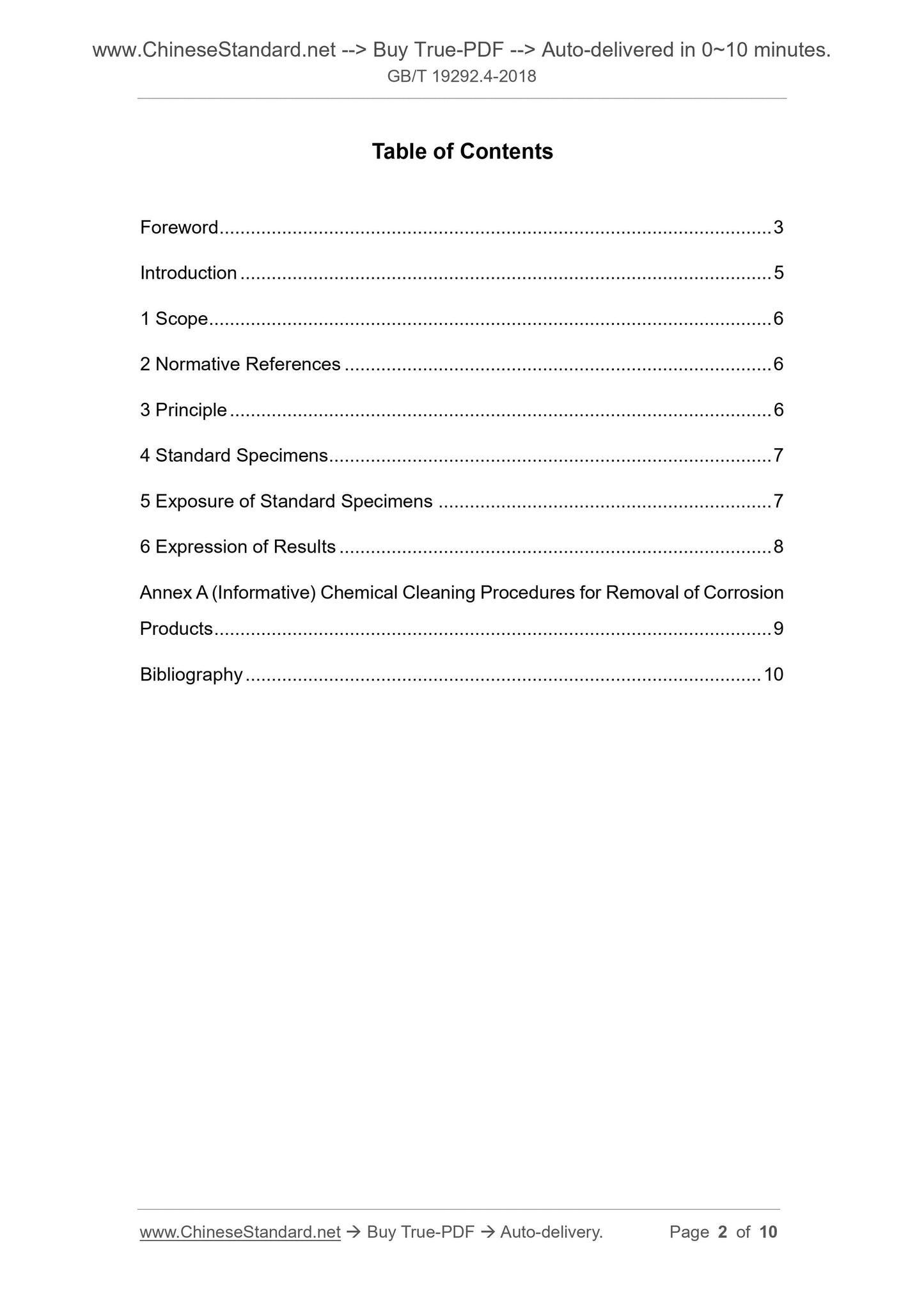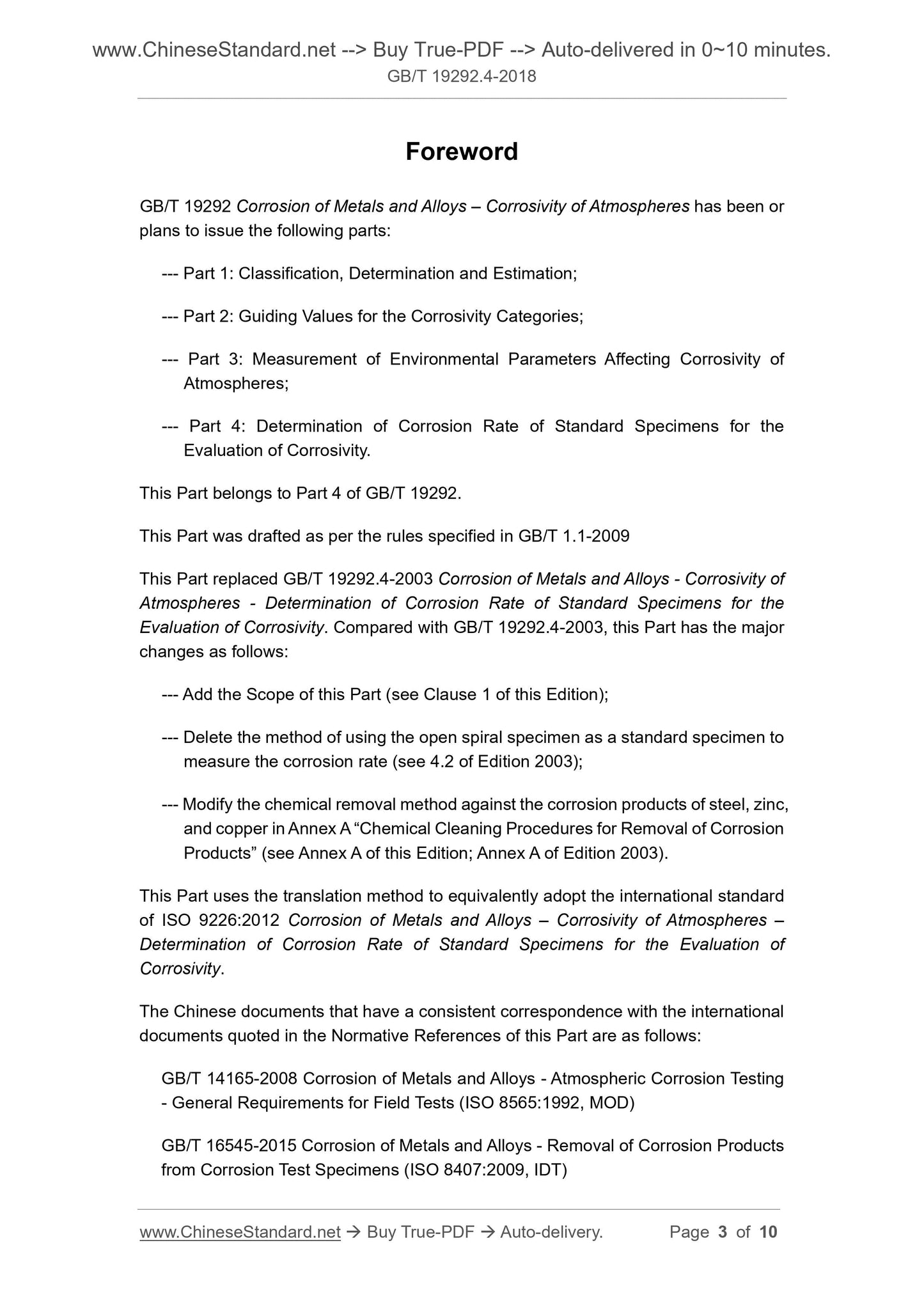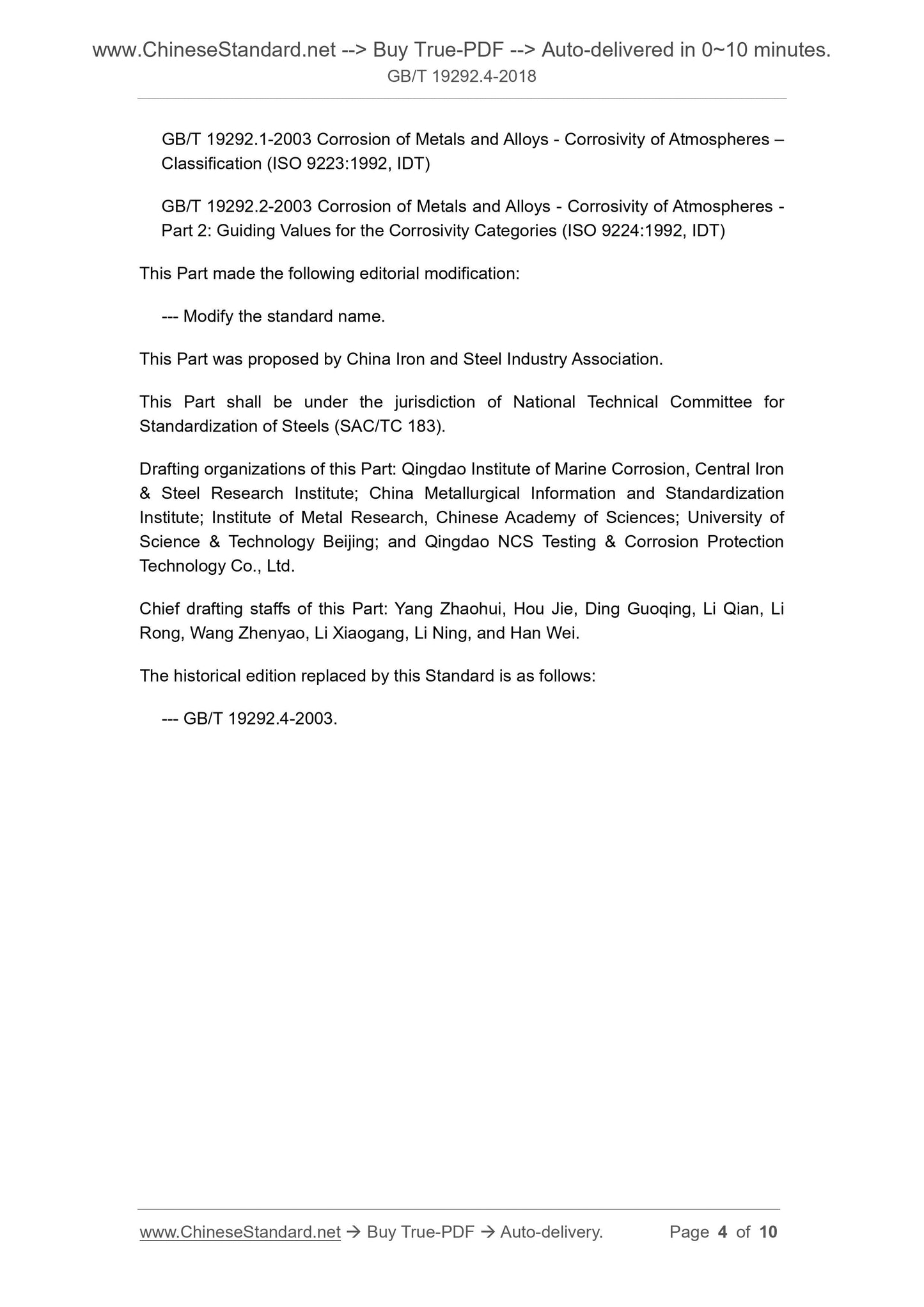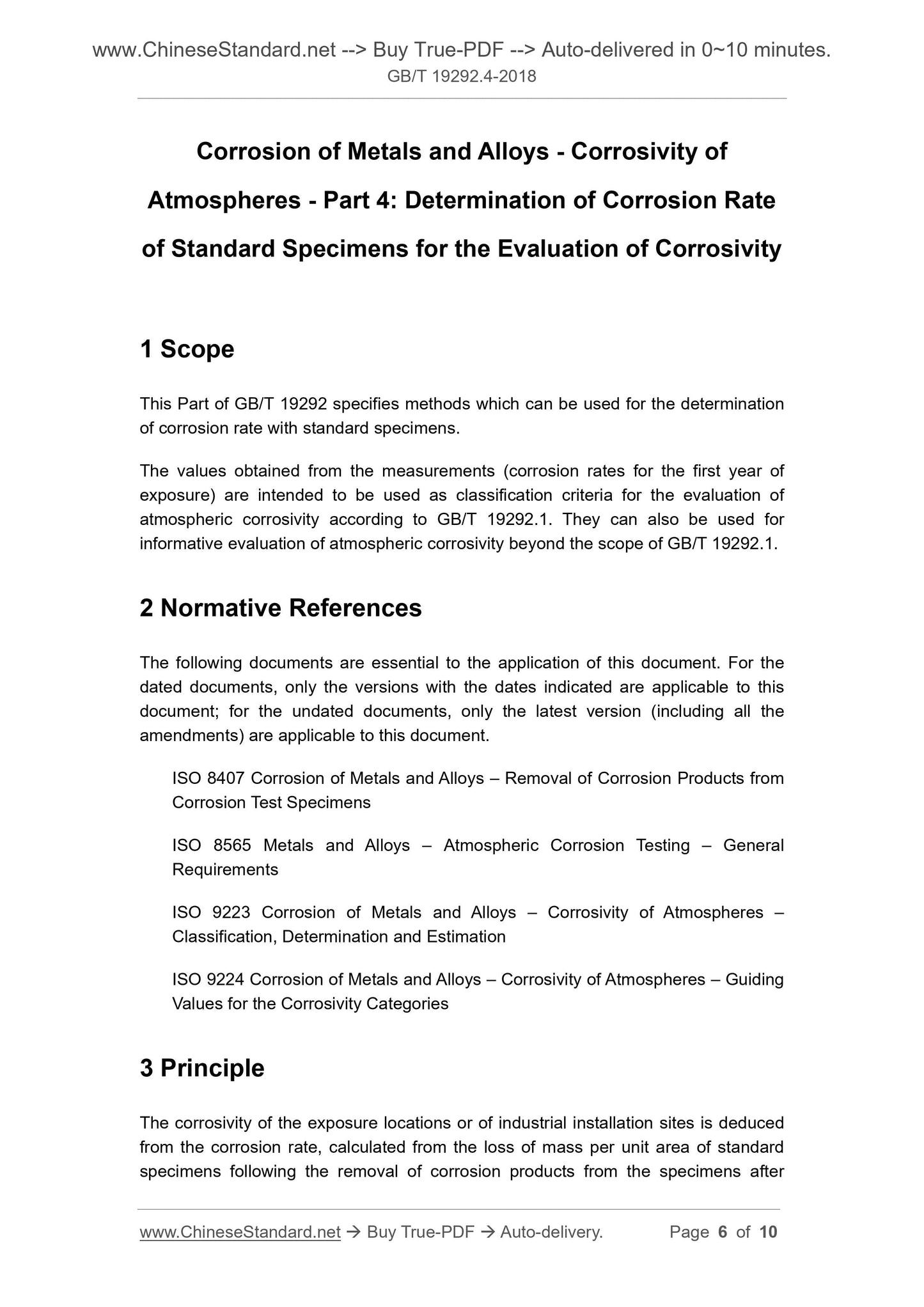1
/
of
5
www.ChineseStandard.us -- Field Test Asia Pte. Ltd.
GB/T 19292.4-2018 English PDF (GB/T19292.4-2018)
GB/T 19292.4-2018 English PDF (GB/T19292.4-2018)
Regular price
$110.00
Regular price
Sale price
$110.00
Unit price
/
per
Shipping calculated at checkout.
Couldn't load pickup availability
GB/T 19292.4-2018: Corrosion of metals and alloys -- Corrosivity of atmospheres -- Part 4: Determination of corrosion rate of standard specimens for the evaluation of corrosivity
Delivery: 9 seconds. Download (& Email) true-PDF + Invoice.
Get Quotation: Click GB/T 19292.4-2018 (Self-service in 1-minute)
Historical versions (Master-website): GB/T 19292.4-2018
Preview True-PDF (Reload/Scroll-down if blank)
GB/T 19292.4-2018
(Corrosion of metals and alloys - Atmospheric corrosion - Part 4. Determination of the corrosion rate of standard specimens for the evaluation of corrosivity)
ICS 77.060
H25
National Standards of People's Republic of China
Replace GB/T 19292.4-2003
Corrosion of metals and alloys
Part 4. Standard specimens for evaluation of corrosivity
Determination of corrosion rate
Part 4.Determinationofcorrosionrateofstandardspecimensfor
(ISO 9226.2012, Corrosionofmetalsandaloys-Corrosivityofatmospheres-
Evaluationofcorrosivity, IDT)
2018-05-14 released.2019-02-01 implementation
State market supervision and administration
China National Standardization Administration issued
Content
Foreword III
Introduction IV
1 range 1
2 Normative references 1
3 Principle 1
4 standard sample 1
5 exposure of standard samples 2
6 results expression 2
Appendix A (informative) Chemical method for removing corrosion products 3
Reference 4
Foreword
GB/T 19292 "Corrosion of Atmospheric Corrosion of Metals and Alloys" has been or is planned to be released as follows.
--- Part 1. Classification, determination and evaluation;
--- Part 2. Guidance values for corrosion levels;
--- Part 3. Measurement of environmental parameters affecting atmospheric corrosivity;
--- Part 4. Determination of corrosion rate of standard samples for evaluation of corrosivity.
This part is the fourth part of GB/T 19292.
This part is drafted in accordance with the rules given in GB/T 1.1-2009.
This part replaces GB/T 19292.4-2003 "Corrosion of metals and alloys - Atmospheric corrosion - Part 4.
The determination of the corrosion rate of the standard sample, compared with GB/T 19292.4-2003, the main changes are as follows.
--- Increased the scope of application of this section (see Chapter 1);
--- Removed the method of testing the corrosion rate using open spiral specimens as standard specimens (see 4.2 of.2003 edition);
--- Revised the chemical removal method for corrosion products of steel, zinc and copper in Appendix A "Chemical cleaning method for removing corrosion products" (see attached
Record A, Appendix A of the.2003 edition.
This section uses the translation method equivalent to the international standard ISO 9226.2012 "Corrosion of metals and alloys for atmospheric corrosivity for evaluation
Estimation of Corrosion Rate of Corrosive Standard Samples.
The documents of our country that have a consistent correspondence with the international documents referenced in this part are as follows.
GB/T 14165-2008 General requirements for field tests for atmospheric corrosion testing of metals and alloys (ISO 8565.1992, MOD)
GB/T 16545-2015 Corrosion of metals and alloys Corrosion of corrosion products on specimens (ISO 8407.2009, IDT)
GB/T 19292.1-2003 Corrosion of metals and alloys - Part 2. Classification, determination and evaluation
(ISO 9223.1992, IDT)
GB/T 19292.2-2003 Corrosion of metals and alloys - Part 2. Guide to corrosion grades
(ISO 9224.1992, IDT)
This section has made the following editorial changes.
--- Modified the standard name.
This part was proposed by the China Iron and Steel Association.
This part is under the jurisdiction of the National Steel Standardization Technical Committee (SAC/TC183).
This section was drafted by. Qingdao Institute of Marine Corrosion, Institute of Metallurgical Industry Information Standards, Institute of Iron and Steel Research, Metals of Chinese Academy of Sciences
Institute, Beijing University of Science and Technology, Qingdao Steel Research Nak Testing and Protection Technology Co., Ltd.
The main drafters of this section. Yang Zhaohui, Hou Jie, Ding Guoqing, Li Qian, Li Yong, Wang Zhenduo, Li Xiaogang, Li Ning, Han Wei.
The previous versions of the standards replaced by this section are.
---GB/T 19292.4-2003.
introduction
Corrosion of atmospheric corrosion test points or service sites can be determined by determining the corrosion rate of standard samples after one year of exposure at this location.
Sign (direct corrosion assessment). The standard specimens are four standard structural materials. flat specimens made of aluminum, copper, steel and zinc. These method generations
It is a very economical method for assessing corrosivity and takes into account all local environmental factors.
Warnings - some of the hazardous chemicals involved in some of the steps included in this section, therefore emphasizing the necessary safety
Protective measures.
Corrosion of metals and alloys
Part 4. Standard specimens for evaluation of corrosivity
Determination of corrosion rate
1 Scope
This part of GB/T 19292 specifies the method used to determine the corrosion rate of a standard sample.
These measurements (corrosion rate of the first year of exposure) will be used as a basis for assessing atmospheric corrosivity in GB/T 19292.1. Also available
Informational evaluation of atmospheric corrosion outside the scope of GB/T 19292.1.
2 Normative references
The following documents are indispensable for the application of this document. For dated references, only dated versions apply to this article.
Pieces. For undated references, the latest edition (including all amendments) applies to this document.
ISO 8407 corrosion of corrosive corrosion products on metals and alloys (Corrosionofmetalsandaloys-Re-
Movalofcorrosionproductsfromcorrosiontestspecimens)
ISO 8565 Metal and Alloy Outdoor Atmospheric Exposure Test Method (Metalsandaloys-Atmosphericcorrosiontes-
ting-Generalrequirements)
Corrosion of corrosive atmospheres of ISO 9223 metals and alloys (Corrosionofmetalsandaloys-Corrosivity
ofatmospheres-Classification,determinationandestimation)
ISO 9224 Corrosion of Corrosive Atmosphere for Metals and Alloys (Corrosionofmetalsand
aloys-Corrosivityofatmospheres-Guidingvaluesforthecorrosivitycategories)
3 Principle
Corrosion at exposure points or industrial equipment locations can be inferred by corrosion rate, which is a standard test after 1 year of exposure.
The weight loss per unit area after the removal of the corrosion product is calculated.
For iron, zinc and copper alloys, weight loss is a reliable measure of corrosion damage. For aluminum alloys, weight loss is corrosive
An effective measurement method. This section describes only corrosion weight loss evaluation, not corrosion penetration evaluation.
The corrosion rate for the first year of exposure can be used to calculate the corrosion rate for long-term exposure according to ISO 9224.
4 standard sample
The sample is a rectangular plate shape, and the recommended size is 100 mm × 150 mm, but not less than 50 mm × 100 mm, and the thickness is about 1 mm.
The materials used to prepare the standard samples are manufactured in the near future, namely.
---Steel. carbon structural steel (Cu 0.03%~0.10%, P< 0.07%);
---Zinc. ≥98.5%;
---Copper. ≥99.5%;
--- Aluminum. ≥99.5%.
All samples should be solvent degreased prior to exposure. The sample should not be affected by grease, in order to achieve this, in the next step
Different solvents are required. If there are visible rust or corrosion products on the surface of the steel, it should be sanded with 120# sandpaper before degreasing.
Corrosion products. Sand blasting and rusting of metals can make their surfaces susceptible to corrosion, so it is not recommended for ISO 9223 corrosive environment.
Surface treatment of standard samples in the class. Copper, zinc and aluminum samples will not be visible if they have visible corrosion products on the surface prior to exposure.
use.
5 Exposure of standard samples
The sample shall be weighed and marked prior to exposure, and the exposure of the sample shall be as specified in ISO 8565.
Three samples of each metal should be exposed for one year, starting with the beginning of the most severe corrosion period in one year.
After exposure, the corrosion products on the sample are removed according to ISO 8407. And reweigh, accurate to 0.1mg. Available
The cleaning method is listed in Appendix A, and the cleaning should be repeated several times in the same process.
6 results expression
The corrosion rate of each metal, expressed as the weight loss per unit area during the exposure time, is calculated according to formula (1).
Rcorr=
Δm
A·t
(1)
In the formula.
Rcorr---corrosion rate in grams per square meter year [g/(m2·a)];
Δm---weight loss, the unit is gram (g);
A --- surface area in square meters (m2);
t --- Exposure time in years (a).
The corrosion rate can also be expressed as the thickness reduction rate, calculated according to equation (2).
Rcorr=
Δm
A·ρ·t
(2)
In the formula.
Rcorr---corrosion rate in micrometers per year (μm/a);
Δm---weight loss, the unit is gram (g);
A --- surface area in square meters (m2);
ρ --- density in grams per cubic centimeter (g/cm 3 );
t --- Exposure time in years (a).
ρFe = 7.86 g/cm3, ρZn = 7.14 g/cm3, ρCu = 8.96 g/cm3, and ρAl = 2.70 g/cm3.
All individual values and average values should be listed in the test report. The average value detected before, during, and after exposure may
The anomalies that affect them should be specified.
Appendix A
(informative appendix)
Chemical method for removing corrosion products
The chemical methods for removing corrosion products are shown in Table A.1.
Table A.1 Chemical methods for removing corrosion products
Material Chemical Time/min Temperature/°C Remarks
500mL HCl (ρ=1.19g/mL)
3.5g hexamethylenetetramine plus distilled water to 1000mL
10 20~25
In some cases, it may be necessary to increase the pickling
Number or time
250g glycine (NH2CH2COOH)
Add distilled water to 1000mL (saturated solution)
1~10 20~25 -
Copper 50g sulfamic acid plus distilled water to 1000mL 5~10 20~25 -
50mLH3PO4 (ρ=1.69g/mL)
20gCrO3
Add distilled water to 1000mL
5~10 80
If the corrosion product is not cleaned, press below
Nitric acid cleaning program continues to clean
HNO3 (ρ=1.42g/mL) 1~5 20~25
Remove excess deposits and loose corrosion
Product to avoid reaction, resulting in matrix gold
Over corrosion
references
[1] EN485-1, Aluminiumandaluminalaloys-Sheet, stripandplate-Part 1. Technicalcon-
Ditionsforinspectionanddelivery
[2] EN485-2, Aluminiumandaluminiumaloys-Sheet, stripandplate-Part 2. Mechanicalproper-
Ties
[3] EN1179, Zincandzincaloys-Primaryzinc
[4] EN1652, Copperandcopperaloys-Plate,sheet,stripandcirclesforgeneralpurposes
[5] EN10130, Coldroledlowcarbonsteelflatproductsforcoldforming-Technicaldeliverycondi-
Tions
GB/T 19292.4-2018
(Corrosion of metals and alloys - Atmospheric corrosion - Part 4. Determination of the corrosion rate of standard specimens for the evaluation of corrosivity)
ICS 77.060
H25
National Standards of People's Republic of China
Replace GB/T 19292.4-2003
Corrosion of metals and alloys
Part 4. Standard specimens for evaluation of corrosivity
Determination of corrosion rate
Part 4.Determinationofcorrosionrateofstandardspecimensfor
(ISO 9226.2012, Corrosionofmetalsandaloys-Corrosivityofatmospheres-
Evaluationofcorrosivity, IDT)
2018-05-14 released.2019-02-01 implementation
State market supervision and administration
China National Standardization Administration issued
Content
Foreword III
Introduction IV
1 range 1
2 Normative references 1
3 Principle 1
4 standard sample 1
5 exposure of standard samples 2
6 results expression 2
Appendix A (informative) Chemical method for removing corrosion products 3
Reference 4
Foreword
GB/T 19292 "Corrosion of Atmospheric Corrosion of Metals and Alloys" has been or is planned to be released as follows.
--- Part 1. Classification, determination and evaluation;
--- Part 2. Guidance values for corrosion levels;
--- Part 3. Measurement of environmental parameters affecting atmospheric corrosivity;
--- Part 4. Determination of corrosion rate of standard samples for evaluation of corrosivity.
This part is the fourth part of GB/T 19292.
This part is drafted in accordance with the rules given in GB/T 1.1-2009.
This part replaces GB/T 19292.4-2003 "Corrosion of metals and alloys - Atmospheric corrosion - Part 4.
The determination of the corrosion rate of the standard sample, compared with GB/T 19292.4-2003, the main changes are as follows.
--- Increased the scope of application of this section (see Chapter 1);
--- Removed the method of testing the corrosion rate using open spiral specimens as standard specimens (see 4.2 of.2003 edition);
--- Revised the chemical removal method for corrosion products of steel, zinc and copper in Appendix A "Chemical cleaning method for removing corrosion products" (see attached
Record A, Appendix A of the.2003 edition.
This section uses the translation method equivalent to the international standard ISO 9226.2012 "Corrosion of metals and alloys for atmospheric corrosivity for evaluation
Estimation of Corrosion Rate of Corrosive Standard Samples.
The documents of our country that have a consistent correspondence with the international documents referenced in this part are as follows.
GB/T 14165-2008 General requirements for field tests for atmospheric corrosion testing of metals and alloys (ISO 8565.1992, MOD)
GB/T 16545-2015 Corrosion of metals and alloys Corrosion of corrosion products on specimens (ISO 8407.2009, IDT)
GB/T 19292.1-2003 Corrosion of metals and alloys - Part 2. Classification, determination and evaluation
(ISO 9223.1992, IDT)
GB/T 19292.2-2003 Corrosion of metals and alloys - Part 2. Guide to corrosion grades
(ISO 9224.1992, IDT)
This section has made the following editorial changes.
--- Modified the standard name.
This part was proposed by the China Iron and Steel Association.
This part is under the jurisdiction of the National Steel Standardization Technical Committee (SAC/TC183).
This section was drafted by. Qingdao Institute of Marine Corrosion, Institute of Metallurgical Industry Information Standards, Institute of Iron and Steel Research, Metals of Chinese Academy of Sciences
Institute, Beijing University of Science and Technology, Qingdao Steel Research Na...
Delivery: 9 seconds. Download (& Email) true-PDF + Invoice.
Get Quotation: Click GB/T 19292.4-2018 (Self-service in 1-minute)
Historical versions (Master-website): GB/T 19292.4-2018
Preview True-PDF (Reload/Scroll-down if blank)
GB/T 19292.4-2018
(Corrosion of metals and alloys - Atmospheric corrosion - Part 4. Determination of the corrosion rate of standard specimens for the evaluation of corrosivity)
ICS 77.060
H25
National Standards of People's Republic of China
Replace GB/T 19292.4-2003
Corrosion of metals and alloys
Part 4. Standard specimens for evaluation of corrosivity
Determination of corrosion rate
Part 4.Determinationofcorrosionrateofstandardspecimensfor
(ISO 9226.2012, Corrosionofmetalsandaloys-Corrosivityofatmospheres-
Evaluationofcorrosivity, IDT)
2018-05-14 released.2019-02-01 implementation
State market supervision and administration
China National Standardization Administration issued
Content
Foreword III
Introduction IV
1 range 1
2 Normative references 1
3 Principle 1
4 standard sample 1
5 exposure of standard samples 2
6 results expression 2
Appendix A (informative) Chemical method for removing corrosion products 3
Reference 4
Foreword
GB/T 19292 "Corrosion of Atmospheric Corrosion of Metals and Alloys" has been or is planned to be released as follows.
--- Part 1. Classification, determination and evaluation;
--- Part 2. Guidance values for corrosion levels;
--- Part 3. Measurement of environmental parameters affecting atmospheric corrosivity;
--- Part 4. Determination of corrosion rate of standard samples for evaluation of corrosivity.
This part is the fourth part of GB/T 19292.
This part is drafted in accordance with the rules given in GB/T 1.1-2009.
This part replaces GB/T 19292.4-2003 "Corrosion of metals and alloys - Atmospheric corrosion - Part 4.
The determination of the corrosion rate of the standard sample, compared with GB/T 19292.4-2003, the main changes are as follows.
--- Increased the scope of application of this section (see Chapter 1);
--- Removed the method of testing the corrosion rate using open spiral specimens as standard specimens (see 4.2 of.2003 edition);
--- Revised the chemical removal method for corrosion products of steel, zinc and copper in Appendix A "Chemical cleaning method for removing corrosion products" (see attached
Record A, Appendix A of the.2003 edition.
This section uses the translation method equivalent to the international standard ISO 9226.2012 "Corrosion of metals and alloys for atmospheric corrosivity for evaluation
Estimation of Corrosion Rate of Corrosive Standard Samples.
The documents of our country that have a consistent correspondence with the international documents referenced in this part are as follows.
GB/T 14165-2008 General requirements for field tests for atmospheric corrosion testing of metals and alloys (ISO 8565.1992, MOD)
GB/T 16545-2015 Corrosion of metals and alloys Corrosion of corrosion products on specimens (ISO 8407.2009, IDT)
GB/T 19292.1-2003 Corrosion of metals and alloys - Part 2. Classification, determination and evaluation
(ISO 9223.1992, IDT)
GB/T 19292.2-2003 Corrosion of metals and alloys - Part 2. Guide to corrosion grades
(ISO 9224.1992, IDT)
This section has made the following editorial changes.
--- Modified the standard name.
This part was proposed by the China Iron and Steel Association.
This part is under the jurisdiction of the National Steel Standardization Technical Committee (SAC/TC183).
This section was drafted by. Qingdao Institute of Marine Corrosion, Institute of Metallurgical Industry Information Standards, Institute of Iron and Steel Research, Metals of Chinese Academy of Sciences
Institute, Beijing University of Science and Technology, Qingdao Steel Research Nak Testing and Protection Technology Co., Ltd.
The main drafters of this section. Yang Zhaohui, Hou Jie, Ding Guoqing, Li Qian, Li Yong, Wang Zhenduo, Li Xiaogang, Li Ning, Han Wei.
The previous versions of the standards replaced by this section are.
---GB/T 19292.4-2003.
introduction
Corrosion of atmospheric corrosion test points or service sites can be determined by determining the corrosion rate of standard samples after one year of exposure at this location.
Sign (direct corrosion assessment). The standard specimens are four standard structural materials. flat specimens made of aluminum, copper, steel and zinc. These method generations
It is a very economical method for assessing corrosivity and takes into account all local environmental factors.
Warnings - some of the hazardous chemicals involved in some of the steps included in this section, therefore emphasizing the necessary safety
Protective measures.
Corrosion of metals and alloys
Part 4. Standard specimens for evaluation of corrosivity
Determination of corrosion rate
1 Scope
This part of GB/T 19292 specifies the method used to determine the corrosion rate of a standard sample.
These measurements (corrosion rate of the first year of exposure) will be used as a basis for assessing atmospheric corrosivity in GB/T 19292.1. Also available
Informational evaluation of atmospheric corrosion outside the scope of GB/T 19292.1.
2 Normative references
The following documents are indispensable for the application of this document. For dated references, only dated versions apply to this article.
Pieces. For undated references, the latest edition (including all amendments) applies to this document.
ISO 8407 corrosion of corrosive corrosion products on metals and alloys (Corrosionofmetalsandaloys-Re-
Movalofcorrosionproductsfromcorrosiontestspecimens)
ISO 8565 Metal and Alloy Outdoor Atmospheric Exposure Test Method (Metalsandaloys-Atmosphericcorrosiontes-
ting-Generalrequirements)
Corrosion of corrosive atmospheres of ISO 9223 metals and alloys (Corrosionofmetalsandaloys-Corrosivity
ofatmospheres-Classification,determinationandestimation)
ISO 9224 Corrosion of Corrosive Atmosphere for Metals and Alloys (Corrosionofmetalsand
aloys-Corrosivityofatmospheres-Guidingvaluesforthecorrosivitycategories)
3 Principle
Corrosion at exposure points or industrial equipment locations can be inferred by corrosion rate, which is a standard test after 1 year of exposure.
The weight loss per unit area after the removal of the corrosion product is calculated.
For iron, zinc and copper alloys, weight loss is a reliable measure of corrosion damage. For aluminum alloys, weight loss is corrosive
An effective measurement method. This section describes only corrosion weight loss evaluation, not corrosion penetration evaluation.
The corrosion rate for the first year of exposure can be used to calculate the corrosion rate for long-term exposure according to ISO 9224.
4 standard sample
The sample is a rectangular plate shape, and the recommended size is 100 mm × 150 mm, but not less than 50 mm × 100 mm, and the thickness is about 1 mm.
The materials used to prepare the standard samples are manufactured in the near future, namely.
---Steel. carbon structural steel (Cu 0.03%~0.10%, P< 0.07%);
---Zinc. ≥98.5%;
---Copper. ≥99.5%;
--- Aluminum. ≥99.5%.
All samples should be solvent degreased prior to exposure. The sample should not be affected by grease, in order to achieve this, in the next step
Different solvents are required. If there are visible rust or corrosion products on the surface of the steel, it should be sanded with 120# sandpaper before degreasing.
Corrosion products. Sand blasting and rusting of metals can make their surfaces susceptible to corrosion, so it is not recommended for ISO 9223 corrosive environment.
Surface treatment of standard samples in the class. Copper, zinc and aluminum samples will not be visible if they have visible corrosion products on the surface prior to exposure.
use.
5 Exposure of standard samples
The sample shall be weighed and marked prior to exposure, and the exposure of the sample shall be as specified in ISO 8565.
Three samples of each metal should be exposed for one year, starting with the beginning of the most severe corrosion period in one year.
After exposure, the corrosion products on the sample are removed according to ISO 8407. And reweigh, accurate to 0.1mg. Available
The cleaning method is listed in Appendix A, and the cleaning should be repeated several times in the same process.
6 results expression
The corrosion rate of each metal, expressed as the weight loss per unit area during the exposure time, is calculated according to formula (1).
Rcorr=
Δm
A·t
(1)
In the formula.
Rcorr---corrosion rate in grams per square meter year [g/(m2·a)];
Δm---weight loss, the unit is gram (g);
A --- surface area in square meters (m2);
t --- Exposure time in years (a).
The corrosion rate can also be expressed as the thickness reduction rate, calculated according to equation (2).
Rcorr=
Δm
A·ρ·t
(2)
In the formula.
Rcorr---corrosion rate in micrometers per year (μm/a);
Δm---weight loss, the unit is gram (g);
A --- surface area in square meters (m2);
ρ --- density in grams per cubic centimeter (g/cm 3 );
t --- Exposure time in years (a).
ρFe = 7.86 g/cm3, ρZn = 7.14 g/cm3, ρCu = 8.96 g/cm3, and ρAl = 2.70 g/cm3.
All individual values and average values should be listed in the test report. The average value detected before, during, and after exposure may
The anomalies that affect them should be specified.
Appendix A
(informative appendix)
Chemical method for removing corrosion products
The chemical methods for removing corrosion products are shown in Table A.1.
Table A.1 Chemical methods for removing corrosion products
Material Chemical Time/min Temperature/°C Remarks
500mL HCl (ρ=1.19g/mL)
3.5g hexamethylenetetramine plus distilled water to 1000mL
10 20~25
In some cases, it may be necessary to increase the pickling
Number or time
250g glycine (NH2CH2COOH)
Add distilled water to 1000mL (saturated solution)
1~10 20~25 -
Copper 50g sulfamic acid plus distilled water to 1000mL 5~10 20~25 -
50mLH3PO4 (ρ=1.69g/mL)
20gCrO3
Add distilled water to 1000mL
5~10 80
If the corrosion product is not cleaned, press below
Nitric acid cleaning program continues to clean
HNO3 (ρ=1.42g/mL) 1~5 20~25
Remove excess deposits and loose corrosion
Product to avoid reaction, resulting in matrix gold
Over corrosion
references
[1] EN485-1, Aluminiumandaluminalaloys-Sheet, stripandplate-Part 1. Technicalcon-
Ditionsforinspectionanddelivery
[2] EN485-2, Aluminiumandaluminiumaloys-Sheet, stripandplate-Part 2. Mechanicalproper-
Ties
[3] EN1179, Zincandzincaloys-Primaryzinc
[4] EN1652, Copperandcopperaloys-Plate,sheet,stripandcirclesforgeneralpurposes
[5] EN10130, Coldroledlowcarbonsteelflatproductsforcoldforming-Technicaldeliverycondi-
Tions
GB/T 19292.4-2018
(Corrosion of metals and alloys - Atmospheric corrosion - Part 4. Determination of the corrosion rate of standard specimens for the evaluation of corrosivity)
ICS 77.060
H25
National Standards of People's Republic of China
Replace GB/T 19292.4-2003
Corrosion of metals and alloys
Part 4. Standard specimens for evaluation of corrosivity
Determination of corrosion rate
Part 4.Determinationofcorrosionrateofstandardspecimensfor
(ISO 9226.2012, Corrosionofmetalsandaloys-Corrosivityofatmospheres-
Evaluationofcorrosivity, IDT)
2018-05-14 released.2019-02-01 implementation
State market supervision and administration
China National Standardization Administration issued
Content
Foreword III
Introduction IV
1 range 1
2 Normative references 1
3 Principle 1
4 standard sample 1
5 exposure of standard samples 2
6 results expression 2
Appendix A (informative) Chemical method for removing corrosion products 3
Reference 4
Foreword
GB/T 19292 "Corrosion of Atmospheric Corrosion of Metals and Alloys" has been or is planned to be released as follows.
--- Part 1. Classification, determination and evaluation;
--- Part 2. Guidance values for corrosion levels;
--- Part 3. Measurement of environmental parameters affecting atmospheric corrosivity;
--- Part 4. Determination of corrosion rate of standard samples for evaluation of corrosivity.
This part is the fourth part of GB/T 19292.
This part is drafted in accordance with the rules given in GB/T 1.1-2009.
This part replaces GB/T 19292.4-2003 "Corrosion of metals and alloys - Atmospheric corrosion - Part 4.
The determination of the corrosion rate of the standard sample, compared with GB/T 19292.4-2003, the main changes are as follows.
--- Increased the scope of application of this section (see Chapter 1);
--- Removed the method of testing the corrosion rate using open spiral specimens as standard specimens (see 4.2 of.2003 edition);
--- Revised the chemical removal method for corrosion products of steel, zinc and copper in Appendix A "Chemical cleaning method for removing corrosion products" (see attached
Record A, Appendix A of the.2003 edition.
This section uses the translation method equivalent to the international standard ISO 9226.2012 "Corrosion of metals and alloys for atmospheric corrosivity for evaluation
Estimation of Corrosion Rate of Corrosive Standard Samples.
The documents of our country that have a consistent correspondence with the international documents referenced in this part are as follows.
GB/T 14165-2008 General requirements for field tests for atmospheric corrosion testing of metals and alloys (ISO 8565.1992, MOD)
GB/T 16545-2015 Corrosion of metals and alloys Corrosion of corrosion products on specimens (ISO 8407.2009, IDT)
GB/T 19292.1-2003 Corrosion of metals and alloys - Part 2. Classification, determination and evaluation
(ISO 9223.1992, IDT)
GB/T 19292.2-2003 Corrosion of metals and alloys - Part 2. Guide to corrosion grades
(ISO 9224.1992, IDT)
This section has made the following editorial changes.
--- Modified the standard name.
This part was proposed by the China Iron and Steel Association.
This part is under the jurisdiction of the National Steel Standardization Technical Committee (SAC/TC183).
This section was drafted by. Qingdao Institute of Marine Corrosion, Institute of Metallurgical Industry Information Standards, Institute of Iron and Steel Research, Metals of Chinese Academy of Sciences
Institute, Beijing University of Science and Technology, Qingdao Steel Research Na...
Share
